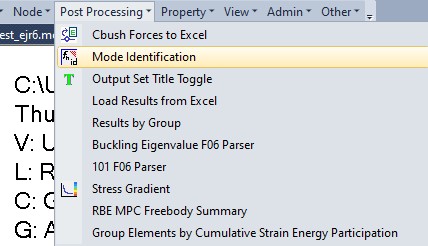|
Mode Identification via Element Strain Energy and Element Kinetic Energy Author: Eric Roulo Description: This script post-processes Nastran elemental strain energy and kinetic energy by mode and FEMAP group to help identify individual mode characteristics in a structural way. Use Instructions: After installing the engineering tools, you will have the engineering tools toolbar. Select "Mode Identification" from the Post Processing Menu.
This will launch the Mode Identification dialogue window.
Additional Options allow you to include the modal effective mass fraction data included in the .f06 file in the processed data. You can also generate group based output data to visualize the total strain and kinetic energy. This feature takes a long time and requires diligence in setting up your groups to not have any element overlap. Caution is recommended. After selecting OK, you will be requested to select the .f06 file from the Nastran run (if selected) and output sets and groups you wish to process.
Run API, follow dialogue and message window prompts. This will include selecting the output sets with the modes of interest and the Femap groups (containing elements) over which to sum energies. Requirements: A) Nastran Solution 103 normal modes output with strain energy and kinetic energy output. B) Param,tiny,1.e-20 included in Nastran bulk deck to ensure all elements report results.
Troubleshooting: energy sum of all elements does not equal 100%. Check that PARAM,TINY,1.E-20 is in bulk deck, rerun as necessary.
Explanation: Modes of vibration are fundamentally an ongoing energy exchange from kinetic energy (EKE) to strain energy (ESE). This method evaluates each user-defined Femap group of elements and sums the elemental kinetic and strain energy for that group. The results are tabularized to allow the analyst to quickly identify the components of the structure that are contributing to the mode of vibration. Groups high in kinetic energy are fundamentally 'causing' the mode, while groups high in strain energy are where the energy goes while passing through zero velocity. To change the mode, the groups with high strain energy will have the largest impact on the frequency. A group with both high kinetic and strain energy are considered self-contained modes such as a panel drum head mode. This allows for easy identification of individual covers or PCB's in large, built-up assemblies. Good design would keep major components an octave away from each other in frequency to minimize dynamic coupling. Energy methods allow for a more detailed analysis of modes that might otherwise not be easy to identify in modal effective mass tables due to overall low participation. The total energy (percent) for each mode will be 100%, so the method does not provide insight into which modes drive primary loads like the modal effective mass approach.
|
||
|
||


